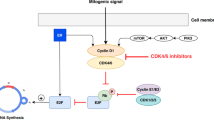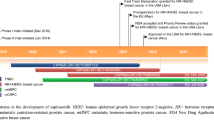Abstract
Background
First- and second-line chemotherapy with anthracyclines and taxanes in metastatic breast cancer yield a modest improvement in survival with potentially significant toxicity. Subsequent lines of chemotherapy yield response rates of 20–25%, with an unknown impact on survival. Perifosine, an oral alkylphospholipid structurally related to miltefosine, has marked activity against breast cancer cell lines and xenograft models, with broad spectrum cellular effects.
Objectives
To determine the efficacy and toxicity of perifosine in patients with metastatic breast cancer patients after up to 2 lines of prior chemotherapy for advanced disease.
Methods
18 patients were enrolled, and 17 treated, using a loading/maintenance dose schedule, (day 1, 300 mg, maintenance 150 mg days 2–21) every 28 days, until disease progression or unacceptable toxicity.
Results
Median age of patients was 54 (28–69), 16/17 were female, ECOG performance status was 0/1 in 16 patients. Fifteen received at least 1 prior chemotherapy regimen for metastatic disease (maximum 2). A median of 2 cycles (range 1–13) was administered per patient. Sixteen were evaluable for response: 2 had SD for 4 cycles, 1 SD for 13 cycles, 13 progressed by cycle 2. Grade 3/4 drug-related non-hematologic toxicities include: diarrhea (2), vomiting (2), nausea (2), fatigue (2) and anorexia (1). No grade 3/4 hematologic toxicities were seen. Median time to progression was 8 weeks (7–15 weeks).
Conclusion
No objective responses were seen in this group of pretreated metastatic breast cancer patients. Disease stabilization was observed in 19% at 2 months.


Similar content being viewed by others
References
Ferlay J, Bray F, Pisani P, Parkin DM (2004) GLOBOCAN 2002: cancer incidence, mortality and prevalence worldwide IARC cancer base No. 5. version 2.0. IARC Press, Lyon
Chia SKL, Speers C, Kang A et al (2003) The impact of new chemotherapeutic and hormonal agents on the survival of women with metastatic breast cancer (MBC) in a population based cohort. Proc Am Soc Clin Oncol 22:6 (abstr 22)
Stockler M, Wilcken N, Ghersi D, Simes RJ (2000) Systematic reviews of chemotherapy and endocrine therapy in metastatic breast cancer. Cancer Treat Rev 26(3):151–168
Bergh J, Jonsson PE, Glimelius B et al (2001) A systematic overview of chemotherapy effects in breast cancer. Acta Oncol 40(2–3):253–281
Jones D, Ghersi D, Wilcken N (2006) Addition of drug/s to a chemotherapy regimen for metastatic breast cancer. Cochrane Database Syst Rev 3:CD003368
Terwogt JM, Mandjes IA, Sindermann H et al (1999) Phase II trial of topically applied miltefosine solution in patients with skin-metastasized breast cancer. Br J Cancer 79(7–8):1158–1161
Smorenburg CH, Seynaeve C, Bontenbal M et al (2000) Phase II study of miltefosine 6% solution as topical treatment of skin metastases in breast cancer patients. Anticancer Drugs 11(10):825–828
Leonard R, Hardy J, van Tienhoven G et al (2001) Randomized, double-blind, placebo-controlled, multicenter trial of 6% miltefosine solution, a topical chemotherapy in cutaneous metastases from breast cancer. J Clin Oncol 19(21):4150–4159
Hilgard P, Klenner T, Stekar J et al (1997) D-21266, a new heterocyclic alkylphospholipid with antitumor activity. Eur J Cancer 33:442–446
Maly K, Uberall F, Schubert C et al (1995) Interference of new alkylphospholipid analogues with mitogenic signal transduction. Anticancer Drug Des 10:411–425
Arthur G, Bittman R (1998) The inhibition of cell signaling pathways by antitumor ether lipids. Biochim Biophys Acta 1390:85–102
Ruiter GA, Zerp SF, Bartelink H et al (1999) Alkyl-lysophospholipids activate the SAPK/JNK pathway and enhance radiation-induced apoptosis. Cancer Res 59:2457–2463
Verheij M, Ruiter G, Zerp S et al (2002) Low doses of alkyl-lysophospholipids induce MAPK/ERK activation by ligand-independent endocytosis of the epidermal growth factor receptor. Proc Am Assoc Cancer Res,Abstract 1002
Ruiter GA, Zerp SF, Bartelink H et al (2003) Anti-cancer alkyl-lysophospholipids inhibit the phosphatidylinositol 3-kinase-Akt/PKB survival pathway. Anticancer Drugs 14:167–173
Patel V, Lahusen T, Sy T et al (2002) Perifosine, a novel alkylphospholipid, induces p21(WAF1) expression in squamous carcinoma cells though a p53-independent pathway, leading to loss in cyclin-dependent kinase activity and cell cycle arrest. Cancer Res 62:1401–1409
Kondapaka S, Singh S, Dasmahapatra G et al (2003) Perifosine, a novel alkyllysophospholipid, inhibits protein kinase B activation. Mol Cancer Ther 2(11):1093–1103
Investigator’s Brochure Perifosine (D-21266). Edition February 28, 2003. AOI Pharmaceuticals Inc., Stamford CT
Crul M, Rosing H, de Klerk GJ et al (2002) Phase I and pharmacological study of daily oral administration of perifosine (D-21266) in patients with advanced solid tumours. Eur J Cancer 38:1615–1621
Van Ummersen L, Binger K, Volkman J et al (2004) A phase I trial of perifosine (NSC39966) on a loading dose/maintenance dose schedule in patients with advanced cancer. Clin Canc Res 10:7450–7456
Monga M, Messmann RA, Headlee D et al (2002) A phase I trial of oral perifosine in patients with refractory neoplasms. Proc American Soc Clin Oncol, abstract 1837
Wakasugi E, Kobayashi T, Tamaki Y et al (1997) p21(Waf1/Cip1) and p53 protein expression in breast cancer. Am J Clin Pathol 107(6):684–691
Jiang M, Shao ZM, Wu J et al (1997) p21/waf1/cip1 and mdm-2 expression in breast carcinoma patients as related to prognosis. Int J Cancer 74(5):529–534
Caffo O, Doglioni C, Veronese S et al (1996) Prognostic value of p21(WAF1) and p53 expression in breast carcinoma: an immunohistochemical study in 261 patients with long-term follow-up. Clin Cancer Res 2(9):1591–1599
Harari D, Yarden Y (2000) Molecular mechanisms underlying ErbB2/HER2 action in breast cancer. Oncogene 19(53):6102–6114
Therasse P, Arbuck SG, Eisenhauer EA et al (2000) New guidelines to evaluate the response to treatment in solid tumors. European Organization for Research and Treatment of Cancer, National Cancer Institute of the United States, National Cancer Institute of Canada. J Natl Cancer Inst 92:205–216
Simon R (1989) Optimal two-stage designs for phase II clinical trials. Controlled Clin Trials 10:1–10
Knowling M, Blackstein M, Tozer R et al (2005) A phase II study of perifosine (D-21226) in patients with previously untreated metastatic or locally advanced soft tissue sarcoma: A National Cancer Institute of Canada Clinical Trials Group trial. Invest New Drugs 24:435–439
Bailey HH, Mahoney MR, Ettinger DS et al (2006) Phase II study of daily oral perifosine in patients with advanced soft tissue sarcoma. Cancer 107:2462–2467
Argiris A, Cohen E, Karrison T et al (2006) A phase II trial of perifosine, an oral alkylphospholipid, in recurrent or metastatic head and neck cancer. Cancer Biol Ther 5:766–770
Posadas EM, Gulley J, Arlen PM et al (2005) A phase II study of perifosine in androgen independent prostate cancer. Cancer Biol Ther 4:1133–1137
Ernst DS, Eisenhauer E, Wainman N et al (2005) Phase II study of perifosine in previously untreated patients with metastatic melanoma. Invest New Drugs 23:56–75
Acknowledgments
We wish to thank David Kipka, Soo Chin, Robin Cheiken, Anne Iacobucci, Patricia Furlong and Dianne Robbins for data management and clinical trials nursing support, Dr. Sunil Verma (Toronto Sunnybrook Regional Cancer Centre), and Trudey Nicklee (Ontario Cancer Institute) for their support of this project.
Author information
Authors and Affiliations
Corresponding author
Additional information
Supported through NIH/NCI Phase 2 Consortium N01-CM-17107 Grant. N. B. Leighl is the principal investigator. Princess Margaret Hospital Phase 2 Consortium, Ontario, Canada includes Princess Margaret Hospital/University Health Network, Toronto; The Ottawa Hospital Regional Cancer Centre, Ottawa; London Regional Cancer Centre, London; Juravinski Cancer Centre, Hamilton.
Rights and permissions
About this article
Cite this article
Leighl, N.B., Dent, S., Clemons, M. et al. A Phase 2 study of perifosine in advanced or metastatic breast cancer. Breast Cancer Res Treat 108, 87–92 (2008). https://doi.org/10.1007/s10549-007-9584-x
Received:
Accepted:
Published:
Issue Date:
DOI: https://doi.org/10.1007/s10549-007-9584-x




